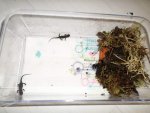Niels D
Well-known member
- Joined
- Jun 2, 2011
- Messages
- 1,339
- Reaction score
- 115
- Points
- 63
- Location
- A little village called Terheijden
- Country
- Netherlands
I've been experimenting with L.laoensis eggs and larvae, just like I did with P.deloustali last year. I don't like "sterile" methods, so I wanted to try raising P. deloustali in pond water while feeding Daphnia. I lost animals in a later stage and on land however. In a later stage, because I kept them too cold (9C and maybe colder). After quickly putting them in the living room a lot of larvae morphed too soon, maybe because of the sudden change in temperature. Lost animals on land probably due to the fact that I fed them tubifex which wasn't cleaned enough on paper towel. There where the animals came in contact with the tubifex, they developed swears, especially on the throat. This also happened with animals which were a year older. I've got 6 healthy juveniles now, feeding them only white worms and fruit flies. When they get bigger I will feed them little earthworms and small slugs as well.
Point is that it was possible to raise them in "ripe water" setups using pond water and that the things that went wrong PROBABLY didn't have to do with the way they were raised. I've got a small amount of L.laoensis eggs and almost all larvae hatched and have survived until now using only pondwater. At this moment 10 animals have morphed, although they are a little bit on the small side with 4.5 centimeters. Their skin looks dry though and I've seen them eat white worms and fruit flies. I'm not feeding tubifex on land anymore.
I will give more details if people are interested. This method is not "universal, because the quality of pond water is diffirent in each pond. The water quality in one pond can differ throughout the year as well. I dared to use water out of my pond, because there's a lot of fresh water isopods and Gammarus in it. They don't thrive in water which is out of ballance.
Point is that it was possible to raise them in "ripe water" setups using pond water and that the things that went wrong PROBABLY didn't have to do with the way they were raised. I've got a small amount of L.laoensis eggs and almost all larvae hatched and have survived until now using only pondwater. At this moment 10 animals have morphed, although they are a little bit on the small side with 4.5 centimeters. Their skin looks dry though and I've seen them eat white worms and fruit flies. I'm not feeding tubifex on land anymore.
I will give more details if people are interested. This method is not "universal, because the quality of pond water is diffirent in each pond. The water quality in one pond can differ throughout the year as well. I dared to use water out of my pond, because there's a lot of fresh water isopods and Gammarus in it. They don't thrive in water which is out of ballance.








